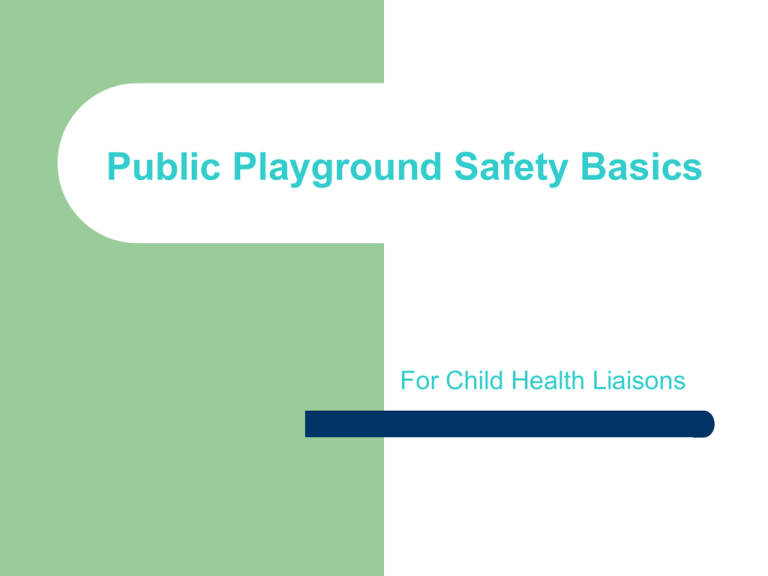Public Playground Safety Basics
advertisement

Public Playground Safety Basics For Child Health Liaisons “Public” Playground Means: Equipment for use in the play areas of parks, schools, child care facilities, institutions, multiple family dwellings, restaurants and recreational developments. What’s the Law in the U.S? There is no U.S national playground safety law. Several states have passed public playground safety laws (Colorado is NOT one of them). Injury Statistics To Gain Insight Into How and Why Injuries Occur. Injury Overview 40 million children between the ages of 212 are injured every year. 205,850 estimated playground equipment related injuries. 76% public. 24% residential. Hazard Patterns – Falls 79% 68% falls to surface 10% falls to other parts of the equipment 1% unknown 4 out of 5 accidents are due to falls Hazard Patterns Impact 11% - Misc. 10% Impact with stationary equipment 8%. Impact with moving equipment 3%. Miscellaneous injuries: Generally contact with pinch points and sharp edges. Priority 1 Hazard Any hazard that could cause an injury which could result in: Death Brain damage Permanent paralysis Loss of vision Loss of speech Loss of limb Organ destruction Major Cause of Death & Seriously Debilitating Injury ENTANGLEMENT of clothing, strings or ropes (#1 cause of deaths) FALLS to hard underlying surfaces (#2 cause of deaths) IMPACT by moving swings, tipped or loose equipment (#3 cause of deaths) Why Do Children Die on Playgrounds Falls – A 7 year old boy died when he fell from top of a 10’ high slide hitting his head on a concrete footer. Entanglement – A 3 year old girl died when the string from her mittens became entangled on the side rails of the slide, causing her jacket to pull up around her neck. Entrapment – A 2 year old boy died when his head became entrapped between the horizontal rails of a climber. Impact – A 6 year old girl died when she was struck in the head with a heavy animal swing form. Ages of Those Injured on Playgrounds < 2 yrs = 3% 2-4 yrs = 27% 5-9 yrs= 56% 10-12 yrs = 12% 13-14 yrs = 2 % Causes of Playground Injuries 45 40 35 30 25 20 15 10 5 0 layout install. equip. mainten. use&sup. 43% equipment use and lack of supervision 37% poor maintenance 10% improper equipment 7% poor installation 3% poor layout Hazard Identification Purpose: to Reduce the Number and Severity of Life Threatening and Seriously Debilitating Injuries Head Entrapment Playground equipment built before the year 1991 will have head entrapments. Children less that 5 years of age are more likely to get head entrapment when they go feet first. Head entrapment probes are used to test bounded openings between 3 ½ to 9 inches. Bicycle Helmets and Head Entrapments There is a “hidden hazard” of strangulation if a child wears a helmet while playing on playground equipment. Two children have died from wearing bicycle helmets during play and died due to hanging from the helmet strap. Arch Climbers NOT recommended for pre-school age (children can go up, but can’t come down. If attached to a platform it’s o.K. Balance Beams Height 2-5 yrs< 12 inches 5-12 yrs<16 inches No trip hazards Guardrails & Barriers 2-5 year old Guardrails 5-12 year old Guardrails Greater than 20 inches Min. Height of 29 inches Max. Opening at lower boundary 23 inches Greater than 30 inches Min. height of 38 inches Max. opening at lower boundary 28 inches Protective barriers Protective Barriers Greater than 30 inches Min. Height 29 inches No opening allows passage of torso probe Greater than 48 inches Min. height 38 inches No opening allows passage of torso probe Metal Slides Not recommended in Colorado May be O.K if there is adequate shading Slides Continued Use zone for slides must be the height of the slide plus 4 feet with a min. Of 6 feet. Note: use zone is the surface under and around a piece of play equipment onto which a child might land when falling from or exiting the equipment. Swings Only two swings per bay. Only one rotating (tire) swing per bay. May not have infant swing and regular swing in same bay. Swings Continued Use zone for swings is twice the height of the swing frame. It must extend both in front and in back. Other Hazards Tires on playgrounds must have adequate drainage holes so water does not pool. Pools and Sand Boxes Wading pools must be emptied after every use! Sand boxes must be covered when not in use so water does not collect inside. Wooden Structures Not recommended for Colorado’s dry climate. Constant maintenance required to prevent splinters. May be treated with creosote or have a lead paint surface. Playground Surfacing Purpose: to Reduce the Severity of Injuries Due to Falls Pea Gravel Gravel loses some resilience in cold weather. Recommended that 7 inches of pea gravel for equipment that is 6 feet high. May become a fall hazard when tracked on concrete. Requires continuous maintenance. Children may put in their noses and ears. Sand Becomes compact in Colorado winter weather and loses its resiliency. Sanitation concerns because it is susceptible to fouling by animals. High maintenance because of displacement under swings and slides. Wood Chips Requires good drainage. Should be topped every 3 years. Displacement will occur under slides and swings. Lightweight so easy to rake and maintain. Shredded Rubber Lightweight so easy to rake and maintain. Non-toxic if swallowed. Does not decompose. Most resilient product on the market. Does not get as hot as sand or pea gravel. More expensive than wood chips. Unitary Synthetic Materials: Rubber Tiles/pour in Place Rubber Good surface for infant or toddlers to crawl. ADA compliant. Clean and easy to maintain. Must be professionally installed. Weather must be mild when installed. Very expensive. Grass Not Allowed As a Cushioning Material Under Equipment! Exemptions to Surfacing Ground level play Standing or seating equipment does not need surfacing Playground Safety Be Pro-active Not Re-active!











